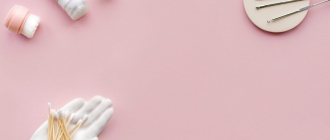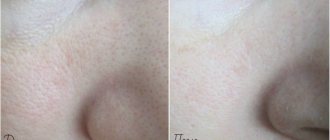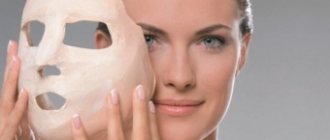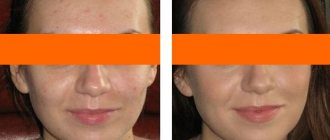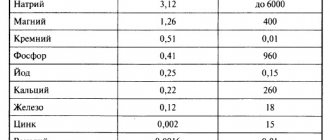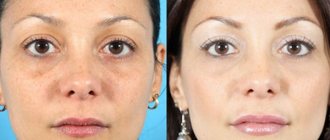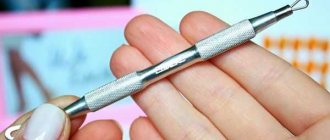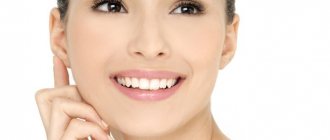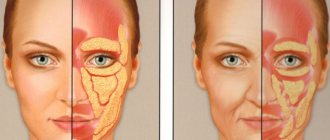- 7423
- 09-10-2020
- Author: Mysekret Team
- 0
It's no secret that the skin is exposed to various factors every day that contribute to its pollution. In addition to the natural processes produced by the body, the influence of the environment is of considerable importance. Dust and dirt mix with fat, thereby clogging pores. As a result, acne, blackheads and other skin problems appear.
The essence of facial cleansing by a cosmetologist
Facial cleansing is the first step towards healthy and beautiful skin. The epidermis contains channels whose main function is to moisturize the skin and produce sebaceous fat. The channels themselves have an outlet - pores. It is not possible to carry out a sufficiently deep cleansing at home, so once every few months it is worth having a professional facial cleansing from a cosmetologist.
Cleaning is a complex of various procedures for cleansing the skin using manual or hardware techniques.
See also...
✅ What can and cannot be done after cleaning with a cosmetologist?
✅ Tips from a cosmetologist for facial care after 40 years
✅ How to use facial concealer?
✅ Ultrasonic facial cleansing at home for acne and blackheads
carried out in the salon allows you to:
- Cleanse pores, removing rashes and irritations;
- Rid the epidermis of toxins and waste;
- Exfoliate the dead layer;
- Improve blood circulation;
- Normalize respiratory, thermoregulatory and protective functions;
- Restore normal metabolism;
- Restore firmness, elasticity and smoothness;
- Refresh your complexion.
After professional cleaning, the epidermis is saturated with oxygen, a feeling of cleanliness and freshness appears, which forces women to return to the salon for treatments.
There is an opinion that young people under 25 years of age are contraindicated from visiting cosmetic centers, since the procedures performed will only harm the epidermis. However, this is a fundamentally erroneous opinion. You can and even need to visit a cosmetologist from adolescence.
The specialist will correctly determine your skin type, advise which procedure is most suitable and how often you should visit the salon, based on each individual case. He will also prescribe the best skin care products to use for your skin.
About mechanical cleaning
The most popular skin cleansing methods are mechanical, ultrasonic, laser, atraumatic and mixed. They are different, but they are united by one goal - to clear clogged pores of dirt and dead cells.
The essence of mechanical cleansing is to use special objects and hands to remove closed and open comedones and pus from sebaceous plugs that were once affected by inflammation.
Tools:
- Spoon Uno. Using one or more holes made in a metal spoon, single pimples and areas with clogged pores are removed;
- Vidal loop. If there is a deep comedone in the center of the loop, then from gradual pressure on the skin it will come out;
- Vidal's needle. The abscesses are punctured, and then the pus is “pushed out” with a Vidal loop.
These are the most commonly used tools for mechanical cleaning. A good device can be purchased at a professional cosmetology store; it should always be disinfected before and after use.
Do not try to squeeze dirt out of the skin yourself if you do not know the basics of handling the tool!
Below is a video that describes general information about such cleaning:
It can remove existing contaminants, but it does not work well as a preventive measure against inflammation. The main cause of acne, excessive production of androgens, cannot be removed by any cosmetic procedure.
Indications and contraindications
It’s worth visiting a cosmetologist in a beauty salon if you have the following indications :
- Comedones;
- Acne and acne;
- Increased or decreased greasiness;
- Enlarged pores;
- Deterioration of skin turgor;
- Decreased tone;
- Uneven complexion;
- Fading epidermis.
Despite the visible effect after cosmetic procedures, professional cleaning has a number of contraindications:
- Skin disease with the presence of pus;
- Bronchial asthma;
- Diabetes;
- Eczema;
- Severe stage of hypertension;
- Herpes;
- Dermatitis;
- Epilepsy and severe forms of mental illness.
Pregnant women are also prohibited from facial cleansing, excluding mechanical and ABR cleansing.
A cosmetologist is a specialist in his field. However, before visiting a cosmetic center, it is recommended to visit a dermatologist, who will identify problems and their causes, and then, if necessary, refer you to a cosmetologist.
Ultrasonic
This procedure is painless and does not injure the epidermis, but does not affect the deeper layers. It is universal, as it is used to treat any type of leather. The mechanism of operation of the device is based on high-frequency vibrations emitted by a metal plate.
They apply pressure to the liquid medium obtained after applying a special gel to the face. As a result, microjets are formed on the surface, improving the separation of keratinized cells.
The procedure consists of several stages and takes about an hour and a half:
- Makeup removal;
- Gel application;
- Exposure to the device (no more than 15 minutes);
- Light massage;
- Using masks or creams.
After ultrasound exposure, inflammation decreases, skin tone improves and pores are cleaned. Contraindications are:
- Exacerbation of acne;
- Acute infectious diseases;
- Wounds and other injuries on the face;
- Tumors;
- Endocrine and heart diseases;
- Epilepsy;
- Neuralgia.
If a cosmetologist does everything in accordance with the technology, then there will be no burns.
Preparation for the procedure
Before the session, the specialist must prepare the skin for the upcoming procedure. This way the effect comes much faster.
The pores need to be opened. To do this, a professional usually uses a steam bath or warming creams. Paraffin masks and heat compresses are also used as another option for preparing the face for the chosen procedure.
However, ultrasonic cleaning does not require opening the pores, therefore, the epidermis is not prepared for the procedure, but proceeds directly to the session.
Types of facial cleansing by a cosmetologist
Based on the type of epidermis and its condition, the cosmetologist prescribes a certain type of cleansing. Each method can only be performed in a specially equipped beauty salon.
Facial cleansing is carried out in the following ways:
- Mechanical;
- Chemical;
- Vacuum;
- Laser;
- Ultrasonic;
- Galvanic.
The methods differ from each other not only in the method used, but also in the pain threshold and cost.
Mechanical
Mechanical facial cleansing is the most popular and in demand method. The procedure has two more names: manual and manual. The principle of this method is that the cosmetologist manually cleanses the skin of dirt. From the outside it may seem that this is just squeezing out pimples, which everyone can deal with on their own at home. However, it is not.
Mechanical facial cleansing has a number of technical nuances:
- Cleaning is carried out from the side, so the master can better see the flaws;
- The client's face is placed under a bright light and a magnifying glass;
- The cosmetologist first applies a special mask, compresses or uses steam to the face to expand the pores;
- After opening the pores, the skin is treated with an antiseptic; the doctor himself wears disinfected gloves;
- Upon completion of the procedure, the specialist again disinfects the epidermis and applies a cream with a soothing, anti-inflammatory and pigment-constricting effect.
Sometimes, to quickly achieve results and prevent inflammatory processes, physical therapy procedures such as darsonval are used.
This method of facial cleansing is called mechanical, because in some cases the cosmetologist uses a small cosmetic spoon to remove pus if it sits deep in the pores.
Do not be alarmed if redness and flaking appear after the procedure, this is a natural reaction that will go away in a couple of days. Also at this time it is better not to use decorative cosmetics, you should protect your skin from sunlight and forget about such strong cleansers as scrubs.
Such a painstaking procedure is ideal for problematic and oily epidermis. In some difficult-to-solve cases, it is the only way out. The procedure itself, although painful, is harmless and effective when done by a specialist. Mechanical cleaning is prescribed for adolescents over 16 years of age and pregnant women.
Chemical
Dry cleaning is a worthy alternative to the manual method. It is less painful and more effective. This procedure can not only remove acne and comedones, but also rid the face of scars and even out the skin texture.
A profound effect on the epidermis occurs due to the acids :
- Fruity;
- Retinol;
- Salicilova.
Chemical cleaning is, in its own way, a peeling that causes a mild burn. The face is covered with a thin brown crust, which will disappear after four days. However, this is necessary, because in this way the keratinized cells of the epidermis are eliminated and the relief is leveled.
After using the chemical method of cleansing your face, try to go outside as little as possible. Be sure to apply cream with SPF of at least 30 and whitening serums.
You need to prepare for this cleansing a month in advance, using daily cosmetic care products with fruit acids. This will contribute to the uniform distribution of the drugs during the session, due to which the effect will occur faster and significantly improve the condition of the skin.
Vacuum
Vacuum cleansing is the most non-traumatic and painless cosmetic procedure for the face, compared to others. Cosmetologists, as a rule, prescribe this method to those with oily skin.
Vacuum cleaning promotes:
- Removing blackheads and impurities;
- Improving blood circulation;
- Increased cellular metabolism;
- Leveling the skin texture;
- Getting rid of stagnant elements (capillary networks, post-acne marks).
The procedure also allows you to clean hard-to-reach places - the wings of the nose and chin. Vacuum cleaning is carried out with a special nozzle, which, under negative air pressure, draws out the contents of the pores and sebaceous plugs.
Laser
Laser beams penetrate deeply into the epidermis, thereby cleansing pores and normalizing the synthesis of collagen and elastin. The facial skin receives proper nutrition and blood supply.
The laser method acts like peeling. After the procedure, the skin takes on a fresh and healthy shade, as pigment spots disappear, pores narrow and metabolic processes are normalized.
One of the advantages of this method is that the laser device is used a few centimeters from the client’s skin, which eliminates the slightest chance of infection.
Laser cleaning is suitable for problematic, oily and porous skin. The surface of the face becomes smooth due to the leveling of the relief, smoothing out wrinkles and scars.
Ultrasonic
Ultrasonic waves, acting on the skin, push out toxins, sebaceous plugs and other types of pollution. This type of cleaning has many advantages :
- Cleansing is deep and high quality;
- Does not require preliminary skin preparation;
- Vibration provides massage at the cellular level;
- The epidermis is not injured at all;
- The procedure is silent;
- There is no recovery period.
Immediately before the procedure, the face is treated with gel, after which the cosmetologist begins cleaning using a wave generator, which looks like a small spatula. The ultrasound method is indicated for those with dry and sensitive epidermis.
Galvanic
Galvanic cleaning also has a second name - disincrustation. The procedure takes place under the influence of a low voltage direct electric current. However, the method is a salvation for problematic skin with oily seborrhea, acne and other inflammations.
The device uses two electrodes: positive and negative. Together with a special product, the charges provide the very therapeutic effect that clients expect.
Galvanic facial cleansing by a cosmetologist is done in four steps:
- Step 1 . The cosmetologist, including a negative charge, softens fat and opens pores. As a result, the contents come out easily;
- Step 2. Excess secretions are saponified with a special cosmetic product, the composition of which enters into chemical reactions. This allows you to disinfect the epidermis, remove remaining contamination and exfoliate the keratinized layer of the epidermis;
- Step 3. A specialist, using cleansing products (wipes, tonic), washes off the saponification products;
- Step 4 . The positive charge closes the pores and restores the acid-base balance.
As a result of disincrustation, the skin acquires a healthy tone, blood circulation and metabolic processes are restored. The current also has some lifting effect, which normalizes the functioning of the sebaceous glands.
What can I say and how can I comment on this video as a professional?
What I liked:
1. The patient is under sedation. I cannot explain in any other way that during the entire session of prying his face open, he does not show any signs of dissatisfaction or discomfort with what is happening. Humble and submissive, like a lamb. Oh yes, cosmetologists in the USA (for example) have the right to prescribe strong painkillers to patients, the same Vicodin (hello, Dr. House!) - for premedication. As a result, the patient is calm and pain-free, and the doctor is comfortable doing his job. And no one has ever become a drug addict after taking two pills.
In Russia, alas, they do not have the right to prescribe similar drugs. As a result, 5 minutes after the start of such cleaning, you will have in front of you a groaning and squirming patient who squeals, “Well, maybe that’s enough? It hurts me! I do not want any more!" - and 90% of the subsequent time you will apologetically persuade your patient to “Be patient a little more.” Do you need this?
Most cosmetologists will be happy to give a client “painless ultrasonic cleaning” by pointlessly crawling across the face with an ultrasonic spatula. It's really painless. But ultrasound peeling will not clear any old pimples, much less closed comedones, alas. Ultrasonic cleaning, also known as ultrasonic peeling, is only for superficial cleansing of pores. I would even say that this product is more for polishing the skin , but not for cleaning.
What is the patient’s concern: if, during a painful manual cleansing of the face, you give up the sanitation and follow the patient’s lead, postponing the remaining comedones “for the next visit” (and according to the rules, you actually have the right to open no more than 10 closed comedones during 1 cleaning) - the patient It just won't come again. Maybe in 3 years, when it all doesn’t grow back on his face to alarming proportions. Tested many times.
Considering the fact that cleaning is not a treatment for comedones (but only a fight against the consequences, see below), you and your patients may not reach all other appointments.
2. Scalpel. The Russian cosmetology school insists on the use of disposable needles when opening closed comedones. But needles are not always effective. If the sebaceous gland cysts are quite large, as in the video, they are generally ineffective. Here you will have to either wait for the “maturation” of inflammatory formations inside the skin, stimulating this maturation in every possible way (there are means), or opening it wide enough with a disposable lancet, as in the video. In practice, this means that the office must have conditions corresponding to, at a minimum, a sterile dressing room. Plus, after the session you will have to completely clean and disinfect the office, just like after a purulent patient. Since some acne “shoots” onto the walls and into the doctor’s face (I have special protective equipment for this, a “welder suit” - that’s what I call it). This sanitation is quite achievable in small cosmetology salons, like mine, but not on a routine basis with an ordinary cosmetologist.
On the other hand, you may ask, “What about the marks after such punctures?” - they certainly will be. But the skin of such patients, as in the video, is already dotted with pronounced scars and post-acne spots. All this legacy can be dealt with at the final stage of acne treatment, when the skin comes to its senses. Chemical peels, resurfacing, etc. But it is pointless to restore an even skin texture until acne is cured. And one more thing: from a medical point of view, chronic inflammatory lesions on the face are much more dangerous than possible aesthetic defects from their opening.
What I didn't like:
1. Collecting blackheads on a glove. Spectacular, yes, there’s no denying it. From time to time, I also demonstrate to the patient during a session what we have “obtained” - so that he understands and sees that he is not suffering in vain. And here in the video, everything that was taken out of the skin of the face was laid out on the doctor’s glove. And the patient has something to show, motivating the high price)))
But overall it's not professional. The extracted material should either be placed in a waste tray or cleaned with sterile wipes.
2. Insufficient preparation of the surgical field. Since the video has almost no cuts or cuts, we, the viewers, can observe how often tampons are changed, how acne is treated before and after opening. And this process personally raises a lot of questions for me.
I can only explain such carelessness by the fact that after cleaning, the patient is prescribed a full course of loading doses of antibiotics.
I also prescribe antibiotics to my patients, but not all of them - only according to individual indications. And this does not cancel facial treatment during cleansing. Plus, after cleansing your face for 20 minutes. I apply an anti-inflammatory and healing mask that includes an antibiotic. Of course, after collecting anamnesis.
- Similar author's channels on YouTube: Dr Sandra Lee (USA), Josefa M. REINA (Spain), Dr. John Gilmore (USA), sumire cooper blackheads s (Japan), 林季儀 JE (Taiwan), BuBuPlus (Australia), KeanaTankentai (Japan). And also, collections of video channels: the already mentioned Cyst Pops & Explosions, All pimples Channel, Ultimate Popping and others.
Stages of procedures
Of course, each procedure has its own nuances and they are prescribed by a specialist after a detailed examination of the skin. Regardless of the type of epidermis and the prescribed procedure, there is a certain sequence of actions.
Stages of facial cleansing by a cosmetologist:
- Stage 1. The specialist performs professional makeup removal. Unfortunately, it is impossible to get rid of cosmetics correctly before the procedure on your own, since special enhanced cosmetics are required for a deep effect;
- Stage 2. Next, the usual skin cleansing : washing with milk/foam/gel and toning;
- Stage 3. The cosmetologist prepares the skin for the upcoming procedure by opening the pores with a chemical disinfectant. Simple steaming harms blood vessels, so professionals use a modern remedy;
- Stage 4. Carrying out the prescribed facial cleansing method ;
- Stage 5. Upon completion of the procedure, the cosmetologist applies a mask to the face irritated by external influences. The mask soothes the skin, heals small wounds and closes pores;
- Stage 6. After the mask, the skin is covered with a thin layer of cream for the face and area around the eyes with SPF filters.
After all stages are completed correctly, the skin takes on a healthy appearance and begins to “breathe.”
Recovery after procedures
Any type of cleansing is effective and aimed at improving the health of the epidermis. The duration of the course is prescribed by the cosmetologist himself, but after the first visit the clients feel much better.
However, such deep cleansing often leads to redness and minor “side effects,” excluding the ultrasonic method. The recovery period is short, from three to five days, but during this time you should be careful.
First, let's find out what exactly can happen to the skin after the procedure and how to deal with it :
- The face will definitely turn red, as it has been subjected to aggressive influences. Redness goes away on its own in the salon, and sometimes later, depending on the sensitivity of the epidermis;
- If there are signs of peeling, use moisturizing and nourishing creams and masks, also use aloe vera gel;
- Sometimes burns occur, especially after a chemical procedure. In this case, aloe gel and ointment with vitamin B, for example, Panthenol, will help;
- Lubricate wounds and irritated areas with iodine. Also apply a clay mask based on mineral water;
- Sometimes acne occurs, from which procedures are designed to get rid of the skin. If this happens, then use antiseptics;
- In extremely rare cases, red spots, bruises and bruises appear on the face. In such cases, you should contact a specialist to change care products.
The skin after a cosmetic session is vulnerable, so it needs special, gentle care more than ever. In order to reduce the likelihood of the above side effects, do not forget about some rules :
- If possible, try not to go outside, as the skin is extremely sensitive to temperature changes and solar radiation;
- Cancel your trip to the beach, pool, solarium, sauna or bathhouse. Contact with water and UV rays will adversely affect the condition of the epidermis - they can cause irritation or provoke the appearance of age spots;
- Keep the use of decorative cosmetics to a minimum. In the first four days you should not wear makeup at all. You should not use cosmetics with a thick, heavy texture, like powder or foundation;
- The youth and freshness of the skin is determined by the presence of moisture in it. Therefore, during the recovery period, it is worth giving up any alcohol, which retains water in the tissues and increases blood supply;
- Avoid touching your face with your hands, even if they are clean. There is a high probability of infection;
- You cannot use scrubs for seven days. Even the softest scrub can injure delicate skin.
Whether you are going to get cleaned by a cosmetologist or not, remember that washing your face with hot tap water is extremely harmful. Hot water dries and clogs the epidermis, which can easily result in a slight burn or irritation. Running water is full of chemicals that disinfect it, but are a strong pest for the face. It is best to use boiled water at room temperature for washing.
Follow the above tips, and the rehabilitation period will be smoother and faster.
How is the procedure performed?
Before cleaning, it is recommended not to visit the solarium for 2-3 weeks and not to peel.
A week before visiting cosmetologists, refuse to visit the pool.
For 2-3 days before cleansing your face, do not use scrubs with abrasive particles.
- The first stage is makeup removal, removal of fat and sweat.
- The second stage is determined by the type of cleaning. The skin on the face is steamed (for mechanical treatment) or special compounds are applied to it.
- The third stage is the procedure. Session duration is from 20 minutes to one and a half hours.
- The fourth stage is treating the skin with antiseptic and soothing compounds.
Pros and cons of facial cleansing by a cosmetologist
Like many other cosmetic procedures, professional facial cleansing has its pros and cons. First, let's identify the positive aspects of facial cleansing by a cosmetologist:
- Efficiency. The procedure in the salon can relieve skin of any type from problematic rashes and irritation. The devices cope with defects of different depths;
- Healthy complexion, normalized metabolic processes, increased tone;
- Convenient session scheduling. Depending on the client’s age and skin type, procedures are prescribed for different periods of time. Some will need one visit per month, others one visit every six months;
- Low pain threshold. Of course, almost every procedure is noticeable and causes discomfort. However, thanks to modern technology, the pain is weak or completely unnoticeable;
- Price. If we take into account the devices used, the professionalism of the cosmetologist and the effectiveness of cleaning, then the price category is acceptable. Cleaning prices are higher only in the most popular salons from well-known specialists;
- Speed of the procedure. Basically, the procedure takes 30-40 minutes, with the exception of the mechanical one.
Now let's move on to the disadvantages of salon cleaning:
- Recovery period. The skin is irritated for several days and requires special care;
- Possible occurrence of allergic reactions and wounds;
- Pimples. In this case, it is worth thinking about the reason for the infection - it could be dirty particles in the air, or it could be the negligence of the cosmetologist. There is a particular risk with the manual method.
Despite the existing side effects, cleaning with a cosmetologist is necessary if you want your skin to be smooth and breathable. Professional deep cleaning allows your face to look much more beautiful and younger.
When preparing the material, consultation was carried out by:
Olga Kirilova (cosmetologist). A specialist with higher medical education and extensive work experience. Helped hundreds of patients cope with various skin problems. Conducts non-hardware and hardware procedures. Proficient in laser and phototherapy techniques.
Share with your friends!
Subscribe to our Yandex.Zen channel or Yandex.Messenger
